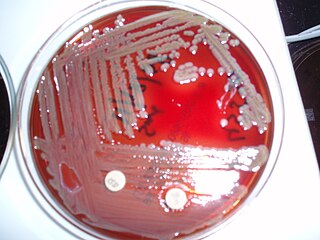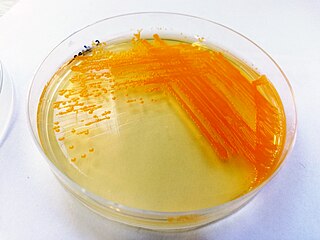Cloacibacterium normanense is a bacterium originally found in wastewater in Norman, Oklahoma. This genus in the family Flavobacteriaceae was new to science when it was described in 2006. It is Gram-negative, non-motile, and facultatively anaerobic. Physically, it is a rod-shaped organism with yellow pigmentation.

The family Flavobacteriaceae is composed of environmental bacteria. Most species are aerobic, while some are microaerobic to anaerobic; for example Ornithobacterium, Capnocytophaga, and Coenonia.

Chryseobacterium is a genus of Gram-negative bacteria. Chryseobacterium species are chemoorganotrophic, rod shape gram-negative bacteria. Chryseobacterium form typical yellow-orange color colonies due to flexirubin-type pigment. The genus contains more than 100 described species from diverse habitats, including freshwater sources, soil, marine fish, and human hosts.
Actibacter is a genus in the phylum Bacteroidetes (Bacteria). The genus contains a single species, namely A. sediminis.
Hymenobacter is a Gram-negative and non-motile bacterial genus from the family of Flavobacteriaceae.
Aequorivita is a Gram-negative and strictly aerobic bacterial genus from the family of Flavobacteriaceae.
Aestuariibaculum suncheonense is a Gram-negative, strictly aerobic, halotolerant and non-motil bacterium from the genus of Aestuariibaculum which has been isolated from tidal flat from the Suncheon bay in Korea.
Aquibacter zeaxanthinifaciens is a Gram-negative, zeaxanthin-producing, strictly aerobic, rod-shaped and non-spore-forming bacterium from the genus of Aquibacter which has been isolated from seawater near Taichung in Taiwan.
Arenibacter is a rod-shaped and strictly aerobic genus from the family of Flavobacteriaceae.
Bizionia is a strictly aerobic genus from the family of Flavobacteriaceae which produce carotenoids. Bizionia is named after Bartolomeo Bizio.
Nubsella is a genus from the family of Sphingobacteriaceae with one known species.
Nubsella zeaxanthinifaciens is a Gram-negative, strictly aerobic and rod-shaped bacterium from the genus of Nubsella which has been isolated from freshwater in Misasa in Japan. Nubsella zeaxanthinifaciens produces zeaxanthin.
Leeuwenhoekiella is a strictly aerobic bacterial genus from the family of Cytophagaceae.
Zobellia is a strictly aerobic genus from the family of Flavobacteriaceae. Zobellia bacteria occur in marine habitats.
Polaribacter is a Gram-negative, heterotrophic, psychrophilic or mesophilic and aerobic bacteria genus from the family of Flavobacteriaceae.
Costertonia is a mesophilic genus of bacteria from the family of Flavobacteriaceae with one known species. The genus Costertonia is named after the American microbiologist J.W. Costerton.
Cruoricaptor is a Gram-negative genus of bacteria from the family of Flavobacteriaceae with one known species.
Canibacter is a genus of bacteria from the family of Flavobacteriaceae with one known species. Croceivirga radicis has been isolated from a rotten mangrove root.
Sabulilitoribacter multivorans is a Gram-negative, aerobic and rod-shaped bacteria from the genus of Sabulilitoribacter which has been isolated from sand from the South Sea in Korea.
Tenacibaculum dicentrarchi is a Gram-negative and rod-shaped bacterium from the genus of Tenacibaculum which has been isolated from the European sea bass from Spain.


